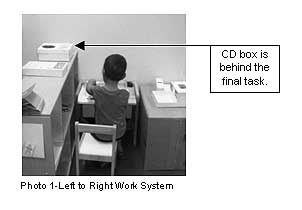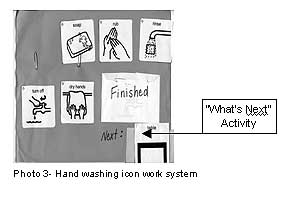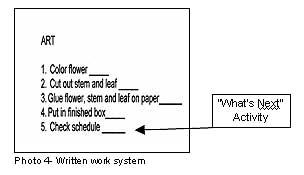Why is Independence Important?
The desire for, and movement towards independence, is a typical developmental milestone for children. The feeling of accomplishment and competence is meaningful and motivating to children as they begin to complete tasks with minimal adult prompting or guidance. This desire for independence is certainly present in children with Autism Spectrum Disorders (ASD). Reaching the maximum level of independence, however, has proved more difficult. The goal of independence is a priority for all children, yet when working with children with ASD, independence is the key to successful community inclusion and future employment.
A variety of sources in the autism community are raising concerns about issues related to independence. The National Research Council recently recommended eight areas of focus for educational development in their book, Educating Children with Autism (2001). Independent organizational skills, which included completing tasks independently and following instructions in a group setting without adult assistance, were highlighted as essential educational objectives. In an article describing an ideal curriculum for students with ASD, Gregory Olley, a psychologist at the University of North Carolina, wrote “The goals of all curricula and methods are to assist students to work independently, to manage their own behavior, and to be motivated by learning and the natural consequences of learning, rather than by artificial reinforcers (1999).” John Kregel, a contributing author to The Forgotten Generation, cites an unemployment rate for individuals with mild cognitive disabilities at a rate of 70-80%, and notes difficulty in demonstrating independent job skills as a contributing factor (2001).
Why is Independence Challenging for Students with ASD?
Establishing independence as a curricular goal is vital, as is gaining an understanding of the possible barriers to independence that students with ASD face. Gary Mesibov, Director of Division TEACCH® (Treatment and Education of Autistic and Related Communication Handicapped Children), explains that students with autism may face several unique challenges when learning. The following difficulties may be an obstacle to the development of independent skills:
Organization is often difficult for students, and the challenge of understanding demands and developing a plan of action may overwhelm or immobilize a student with ASD. Collecting all of the needed materials to complete an assignment may be a complicated organizational demand for a student with ASD.
- Distractibility caused by internal or external factors may also hamper a student’s ability to complete work on his/her own. Students with ASD may have difficulty prioritizing the visual and auditory information in their environment, which may interfere with their independence.
- Sequencing can hinder a student’s ability to become independent, as the relationships between tasks or steps may not be meaningful and may be disregarded by a student with autism. Remembering the exact order of tasks, or steps within a task, may be challenging for students.
- Generalization difficulties are also discussed by Mesibov as a potential impediment to independence. Students with ASD may perform a task independently in one situation or setting, yet may not apply what they have learned in a novel situation. Students may miss the central principles of an activity, instead focusing on the specific details.
- Independent initiation is also difficult for students with ASD, especially during lengthy sequences of activities. A student may have learned to complete the routine in the cafeteria, yet still require prompts to initiate each part of the routine (i.e. get the tray, select the drink, pick up utensils). Individuals with ASD often learn to wait for others to prompt their every move, which results in a lack of independence.
Monitoring the balance between 1:1 instruction and assistance with the awareness that the development of over-reliance may occur is essential when instructing students with ASD. Several studies have shown that students with ASD are not able to continue productive and appropriate responding with the removal of close adult supervision (Dunlap & Johnson, 1985; Dunlap, Koegel, & Johnson, 1987; Stahmer & Shreibman, 1992). Further research indicates that without the reinforcers or contingencies provided by adults, students with ASD have difficulty maintaining independent on-task behavior (Dunlap & Johnson, 1985; Dunlap, Koegel, & Johnson, 1987).
Work Systems to Increase Independence
A work system is a strategy that addresses independence as an essential outcome for students with ASD. A work system, an element of structured teaching, is defined by Division TEACCH® as a systematic and organized presentation of tasks and materials that visually communicates at least four pieces of information to the student (Schopler, Mesibov, & Hearsey, 1995):
- The tasks/steps the student is supposed to do. What is the nature of the task? Does it involve sorting by shape, writing an address, making popcorn, or recycling cans?
- How many tasks/steps there are to be completed. Visually represent how much work is to be done. If a student is to cut 10 coupons, give only 10 coupons so he/she can visualize completion. Steps may be represented by more abstract cues such as numbers, shapes, poker chips, or pictures of high interest items, such as Thomas the Train cars.
- How the student knows he/she is finished. The student should independently recognize the end of the activity through the structure within the task, use of a finished box, timer, or other visual cue such as a stop sign.
- What to do when he/she is finished. Indicate next scheduled activity. May need to use a highly desired item/activity to increase motivation, though often being “finished” is motivating enough.
While a picture schedule directs a student WHERE TO GO, a work system instructs a student on WHAT TO DO once they arrive in the scheduled area. In our own lives, a daily planner may direct us to the grocery store (our schedule), while our grocery list informs us what to do/buy while at the store (our work system). A work system provides all of the required information without adult prompting and teaches the student to attend to visual cues (rather than verbal directives) when completing a task. A work system assists in organizing a student with ASD by providing a systematic work routine—working from left-to-right or top-to-bottom. Students do not have to plan where to begin or how to proceed. Work systems can be used with any type of task or activity (e.g., academic, self-help, leisure), across settings (e.g., independent work area, cafeteria, place of employment), and for individuals at all functioning levels (e.g., systems can range from concrete to abstract).
For example:
Activity: Practice mastered academic tasks (e.g., filing by letter, sorting by color, answering math problems)
Setting: Independent Work Area
Functioning Level: Concrete (using objects)
For a student that has several academic activities to practice independently, the teacher will arrange them in baskets/folders on a shelf to the student’s left. At the end of the row of baskets is a computer CD box, indicating that the computer is the next scheduled activity. The student will complete the first activity and put it in a box/shelf for finished work on the right, then move to the second activity. When all that is left on the shelf is the CD box, the student will transition with the CD box to the computer. (See photo 1)

This system may be adapted for a student with higher level work skills by indicating that the work tasks should be completed in a sequential order. For example, the student has a strip of shapes velcroed to his work space. He has multiple work tasks located on a shelf to his left. To complete tasks in his matching work system, he takes off the square and matches it to the square located on one of the work jobs. This is the task he must complete first. He continues matching shapes to tasks in order to complete the activities in a specified sequential order. When the shapes are matched and the tasks are completed, he takes the photo cue directing him to the next activity (snack). (See photo 2)

Activity: Hand washing
Setting: Bathroom
Functioning Level: More abstract (using icons)
For a student that requires prompting and assistance with the hand washing sequence, a work system can be created for use in the bathroom. Each step of the routine is indicated visually, and as the student completes each step, the icon is placed in the “Finished Pocket.” When the steps are completed and all of the icons are in the pocket, the student knows that hand washing is finished, and is directed to the next activity (e.g., go to the table). (See photo 3)

Activity: Art
Setting: Group Area
Functioning Level: Abstract (following written directions)
For a student that has difficulty following group directions, and sequencing steps to a complex project, a written work system can be used. A written list of the steps required in sequential order, as well as an explicit notion of finished and the next activity, increases independence and task completion. (See photo 4)

Experience with the use of work systems has shown that a student’s overall productivity increases when he/she understands how much work there is to do, as well as when it is finished, and what activity is upcoming. Use of work systems help students with ASD become more organized, more attentive, and more capable in carrying their skills across settings independently. Work systems reduce the number of adult prompts and the use of contingencies and reinforcers, as the structure of the system provides motivation and meaning to the students.
Tips for Implementing Work Systems
- Provide only the materials the student will need for the specific task/activity to decrease confusion.
- Use work systems in a variety of settings (e.g., circle time, social groups, playground, home, doctor visits) to increase generalization across location and adults.
- Teach the work system with minimally invasive prompts so the adult/prompts do not become part of the work routine (e.g., prompt nonverbally, direct students to visual cues, prompt from behind so adult is not part of the student’s visual field, fade prompts as quickly as possible to maximize independence).
- Create smaller, more portable work systems (e.g. in a notebook, file box) for students who travel to different settings throughout the school day.
- Incorporate student’s interests in the visual cues used in the works system (e.g., students can match pictures of SpongeBob on their work system).
References
Dunlap, G. & Johnson, J. (1985). Increasing the independent responding of autistic children with unpredictable supervision. Journal of Applied Behavior Analysis, 18, 227-236.
Dunlap, G., Koegel, R., & Johnson, J. (1987). Maintaining performance of autistic children in community settings using delayed contingencies. Journal of Applied Behavior Analysis, 20, 185-191.
Kregel, J. (2001). Promoting employment opportunities for individuals with mild cognitive limitations. In Tymchuk, A., Lakin, K., & Luckasson, R. (Eds.), The Forgotten Generation (pp. 87-99). Baltimore: Paul H. Brookes.
Mesibov, G. (n.d.) Learning styles of students with autism. Retrieved November 13, 2003 from http://www.teacch.com/edkidsls.htm.
National Research Council. (2001). Educating Children with Autism. Committee on Educational Interventions for Children with Autism. Cathernie Lord and James P. McGee, eds. Division of Behavioral and Social Sciences and Education. Washington DC: National Academy Press.
Olley, G. (1999). Curriculum for students with autism. School Psychology Review, 28, 595-608.
Schopler, E., Mesibov, G., & Hearsey, K. (1995). Structured teaching in the TEACCH® system. In E. Schopler & G. Mesibov (Eds.), Learning and Cognition in Autism (pp. 243-268). New York: Plenum Press.
Stahmer, A., & Schreibman, L. (1992). Teaching children with autism appropriate play in unsupervised environments using a self-management package. Journal of Applied Behavior Analysis, 25, 447-459.
Hume, K. (2004). “I can do it myself!” Using work systems to build independence in students with autism spectrum disorders. The Reporter, 10(1), 4-6, 16.

